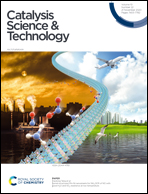Nickel clusters on TiO2(110): thermal chemistry and photocatalytic hydrogen evolution of methanol†
Abstract
In heterogeneous photocatalysis, noble metals such as Au, Pt, or Pd are most commonly used as co-catalysts to facilitate H2 evolution, yet their costs are problematic for applications on a large scale. In this work, we show that the cheaper, more abundant transition metal nickel as co-catalyst material reacts accordingly, when being deposited as small clusters onto rutile TiO2. Different to noble metal systems the photocatalysts undergo photocorrosion, depicted in a declining activity during the photoreforming of methanol. The reaction being performed in an ultra-high vacuum environment allows for a more detailed elucidation of the deactivation processes. Supported by reactivity studies under different conditions, Auger electron spectroscopy reveals that coking of the clusters occurs, while nickel oxide formation is not observed. The study thus shows that nickel co-catalysts are indeed prospective systems for the photocatalytic hydrogen evolution reaction, similar to platinum clusters, but instead may also feature unexpected photon-driven deactivation pathways.



 Please wait while we load your content...
Please wait while we load your content...